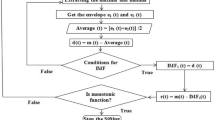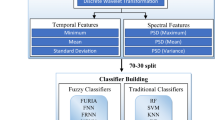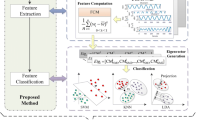Abstract
Epilepsy is a type of brain disorder triggered by an abrupt electrical imbalance of neuronal networks. An electroencephalogram (EEG) is a diagnostic tool to capture the underlying brain mechanisms and detect seizure onset in epileptic patients. To detect seizures, neurologists need to manually monitor EEG recordings for long periods, which is challenging and susceptible to errors depending on expertise and experience. Therefore, automatic identification of seizure and seizure-free EEG signals becomes essential. This study introduces a method based on the features extracted from the phase space reconstruction for classifying seizure and seizure-free EEG signals. The computed features are derived from the elliptical area and interquartile range of the Euclidean distance by varying percentage values of data points ranging from 50 to 100%. We consider two public datasets and evaluate these features in each EEG epoch that includes the healthy, interictal, preictal, and ictal stages of epileptic subjects, utilizing the K-nearest neighbor classifier for classification. Results show that the features have higher values during the seizure than the seizure-free EEG signals and healthy subjects. Furthermore, the proposed features can effectively discriminate seizure EEG signals from the seizure-free and normal subjects with 100% accuracy, sensitivity, and specificity in both datasets. Likewise, the classification between the preictal stage and seizure EEG signals attains 98% accuracy. Overall, the reconstructed phase space features significantly enhance the accuracy of detecting epileptic EEG signals compared with existing methods. This advancement holds great potential in assisting neurologists in swiftly and accurately diagnosing epileptic seizures from EEG signals.






Similar content being viewed by others
Material and/or code availability
The EEG data for this study was obtained from an open-source EEG database from the University of Bonn and Neurology and Sleep Centre of Hauz Khas, New Delhi.
References
Amudhan, S., Gopalkrishna, G., Parthasarathy, S.: Epilepsy in India I: Epidemiology and public health. Ann. Indian Acad. Neurol. 18(3), 263–277 (2015). https://doi.org/10.4103/2F0972-2327.160093
Sukriti, Chakraborty, M., Debjani, M.: Automated detection of epileptic seizures using multiscale and refined composite multiscale dispersion entropy. Chaos Solitons Fractals 146, 110939 (2021). https://doi.org/10.1016/j.chaos.2021.110939
Zhang, T., Wanzhong, C.: LMD based features for the automatic seizure detection of EEG signals using SVM. IEEE Trans. Neural Syst. Rehab. Eng. 25(8), 1100–1108 (2016). https://doi.org/10.1109/TNSRE.2016.2611601
Joshi, V., Pachori, R.B., Vijesh, A.: Classification of ictal and seizure-free EEG signals using fractional linear prediction. Biomed. Signal Process. Control 9, 1–5 (2014). https://doi.org/10.1016/j.bspc.2013.08.006
Ghosh, D.S., Hojjat, A., Nahid, D.: Principal component analysis-enhanced cosine radial basis function neural network for robust epilepsy and seizure detection. IEEE Trans. Biomed. Eng. 55(2), 512–518 (2008). https://doi.org/10.1109/TBME.2007.905490
Zandi, A.S., Javidan, M., Dumont, G.A., Tafreshi, R.: Automated real-time epileptic seizure detection in scalp EEG recordings using an algorithm based on wavelet packet transform. IEEE Trans. Biomed. Eng. 57(7), 1639–1651 (2010). https://doi.org/10.1109/TBME.2010.2046417
Subasi, A.: EEG signal classification using wavelet feature extraction and a mixture of expert model. Expert Syst. Appl. 32(4), 1084–1093 (2007). https://doi.org/10.1016/j.eswa.2006.02.005
Acharya, U.R., Ratna, Y., Jia, W.Z., Muthu, R.K., Jen, H.T., Roshan, J.M., Choo, M.L.: Automated diagnosis of epilepsy using CWT, HOS and texture parameters. Int. J. Neural Syst. 23(3), 1350009 (2013). https://doi.org/10.1142/s0129065713500093
Srinivasan, V., Chikkannan, E., Natarajan, S.: Approximate entropy-based epileptic EEG detection using artificial neural networks. IEEE J. Biomed. Health Inform. 11(3), 288–295 (2007). https://doi.org/10.1109/titb.2006.884369
Ubeyli, E.D.: Lyapunov exponents/probabilistic neural networks for analysis of EEG signals. Expert Syst. Appl. 37(2), 985–992 (2010). https://doi.org/10.1016/j.eswa.2009.05.078
Acharya, U.R., Chua, K.C., Lim, T.-K., Tay, D., Suri, J.: Automatic identification of epileptic EEG signals using nonlinear parameters. J. Mech. Med. Biol. 9(4), 539–553 (2009). https://doi.org/10.1142/S0219519409003152
Jirka, J., Prauzek, M., Krejcar, O., Kuca, K.: Automatic epilepsy detection using fractal dimensions segmentation and GP–SVM classification. Neuropsychiatr. Dis. Treat. 2018, 2439–2449 (2018). https://doi.org/10.2147/2FNDT.S167841
Guler, N.F., Elif, D.U., Inan, G.: Recurrent neural networks employing Lyapunov exponents for EEG signals classification. Expert. Syst. Appl. 29(3), 506–514 (2005). https://doi.org/10.1016/j.eswa.2005.04.011
Peng, G., Nourani, M., Harvey, J., Dave, H.: Feature selection using f-statistic values for EEG signal analysis. Int. Conf. of the IEEE EMBC. 5963–5966 (2020). https://doi.org/10.1109/EMBC44109.2020.9176434
Huang, N.E., Shen, Z., Long, S.R., Wu, M.C., Shih, H.H., Zheng, Q., Yen, N.-C., Tung, C.C., Liu, H.H.: The empirical mode decomposition and the Hilbert spectrum for nonlinear and non-stationary time series analysis. Proc. Math. Phys. Eng. Sci. 454(1971), 903–995 (1998). https://doi.org/10.1098/rspa.1998.0193
Pachori, R.B.: Discrimination between ictal and seizure-free EEG signals using empirical mode decomposition. J. Electr. Comput. Eng 2008, (2008). https://doi.org/10.1155/2008/293056
Pachori, R.B., Bajaj, V.: Analysis of normal and epileptic seizure EEG signals using empirical mode decomposition. Comput. Methods Programs Biomed. 104(3), 373–381 (2011). https://doi.org/10.1016/j.cmpb.2011.03.009
Lu, X., Zhang, J.-Q., Huang, S.-F., Lu, J., Ye, M.-Q., Wang, M.-S.: Detection and classification of epileptic EEG signals by the methods of nonlinear dynamics. Chaos Solitons Fractals 151, 111032 (2021).https://doi.org/10.1016/j.chaos.2021.111032
Sharma, R., Pachori, R.B.: Classification of epileptic seizures in EEG signals based on phase space representation of intrinsic mode functions. Expert Syst. Appl. 42(3), 1106–1117 (2015). https://doi.org/10.1016/j.eswa.2014.08.030
Lee, S.H., Joon, S.L., Jae, K.K., Junggi, Y., Youngho, L.: Classification of normal and epileptic seizure EEG signals using wavelet transform, phase-space reconstruction, and Euclidean distance. Comput. Methods Programs Biomed. 116(1), 10–25 (2014). https://doi.org/10.1016/j.cmpb.2014.04.012
Khan, S.I., Saeed, M.Q., Pachori, R.B.: Automated classification of valvular heart diseases using FBSE-EWT and PSR based geometrical features. Biomed. Signal Process. Control 73,(2022)
Akbari, H., Muhammad, T.S., Rehman, A.U., Mahdieh, G., Rizwan, A.N., Malih, P., Hourieh, B., Hamed, B.: Depression recognition based on the reconstruction of phase space of EEG signals and geometrical features. Appl. Acoust. 179,(2021)
Swami, P., Panigrahi, B., Nara, S., Bhatia, M., Gandhi, T.: EEG epilepsy datasets. (2016). https://doi.org/10.13140/RG.2.2.14280.32006
Andrzejak, R.G., Lehnertz, K., Mormann, F., Reike, C., David, P., Elger, C.E.: Indications of nonlinear deterministic and finite-dimensional structures in time series of brain electrical activity: dependence on recording region and brain state. Phys. Rev. E 64(6),(2001)
Teplan, M.: Fundamentals of EEG measurement. Meas. Sci. Rev. 2(2), 1–11 (2002). http://www.edumed.org.br/cursos/neurociencia/MethodsEEGMeasurement.pdf
Peng, G., Nourani, M., Harvey, J., Dave, H.: Personalized feature selection for wearable EEG monitoring platform. IEEE Int. Conf. Bioinf. Bioen. (BIBE) 380–386 (2020). https://doi.org/10.1109/BIBE50027.2020.00069
Takens, F.: Detecting strange attractors in turbulence. Dynamic Syst Turbulence Warwick. 1980(898), 366–381 (1981). https://doi.org/10.1007/BFb0091924
Tsipouras, M.G.: Spectral information of EEG signals with respect to epilepsy classification. EURASIP J. Adv. Signal. Process. 2019(1), 1–17 (2019). https://doi.org/10.1186/s13634-019-0606-8
Gupta, A., Pushpendra, S., Mandar, K.: A novel signal modeling approach for classification of seizure and seizure-free EEG signals. IEEE Trans. Neural Syst. Rehab. Eng. 26(5), 925–935 (2018). https://doi.org/10.1109/TNSRE.2018.2818123
Sharma, M., Ankit, A.B., Acharya, U.R.: MMSFL-OWFB: a novel class of orthogonal wavelet filters for epileptic seizure detection. Knowl. Based Syst. 160, 265–277 (2018). https://doi.org/10.1016/j.knosys.2018.07.019
Li, Y., Wei, G.C., Hui, H., Yu, Z.G., Ke, L., Tao, T.: Epileptic seizure detection in EEG signals using sparse multiscale radial basis function networks and the Fisher vector approach. Knowl. Based Syst. 164, 96–106 (2019). https://doi.org/10.1016/j.knosys.2018.10.029
Tajmirriahi, M., Amini, Z.: Modeling of seizure and seizure-free EEG signals based on stochastic differential equations. Chaos Solitons Fractals 150, 111104 (2021). https://doi.org/10.1016/j.chaos.2021.111104
Diykh, M., Yan, L., Peng, W.: Classify epileptic EEG signals using weighted complex networks based community structure detection. Expert Syst. Appl. 90, 87–100 (2017). https://doi.org/10.1016/j.eswa.2017.08.012
Ilakiyaselvan, N., Khan, A.N., Shahina, A.: Deep learning approach to detect seizure using reconstructed phase space images. J. Biomed. Res. 34(3), 240–250 (2020). https://doi.org/10.7555/2FJBR.34.20190043
Kaya, Y., Omer, F.E.: A stable feature extraction method in classification epileptic EEG signals. Australas. Phys. Eng. Sci. Med. 41, 721–730 (2018). https://doi.org/10.1007/s13246-018-0669-0
Raghu, S., Sriraam, N., Hegde, A.S., Kubben, P.L.: A novel approach for classification of epileptic seizures using matrix determinant. Expert Syst. Appl. 127, 323–341 (2019). https://doi.org/10.1016/j.eswa.2019.03.021
Acknowledgements
The author Shervin Skaria wishes to acknowledge Mahatma Gandhi University, Kerala, India, for providing fellowship for the research program. The authors also wish to thank the Neurology and Sleep Centre of Hauz Khas, New Delhi, and the University of Bonn for providing the EEG data for the present study.
Author information
Authors and Affiliations
Contributions
The authors confirm their contribution to the paper as follows: Shervin Skaria conducts the preliminary investigation, data analysis, methodology, programming, interprets the results, prepares the figures, and writes the original manuscript. Sreelatha K.S supervised, reviewed, and edited the manuscript. All authors reviewed the results and approved the final version of the manuscript.
Corresponding author
Ethics declarations
Ethics approval and consent to participate
Not required.
Research involving human participants and/or animals
The article contains no studies with human participants performed by the authors.
Informed consent
This study was conducted on a Python, requiring no participation consent.
Competing interests
The authors declare no competing interests.
Additional information
Publisher's Note
Springer Nature remains neutral with regard to jurisdictional claims in published maps and institutional affiliations.
Rights and permissions
Springer Nature or its licensor (e.g. a society or other partner) holds exclusive rights to this article under a publishing agreement with the author(s) or other rightsholder(s); author self-archiving of the accepted manuscript version of this article is solely governed by the terms of such publishing agreement and applicable law.
About this article
Cite this article
Skaria, S., Savithriamma, S.K. Automatic classification of seizure and seizure-free EEG signals based on phase space reconstruction features. J Biol Phys (2024). https://doi.org/10.1007/s10867-024-09654-6
Received:
Accepted:
Published:
DOI: https://doi.org/10.1007/s10867-024-09654-6




